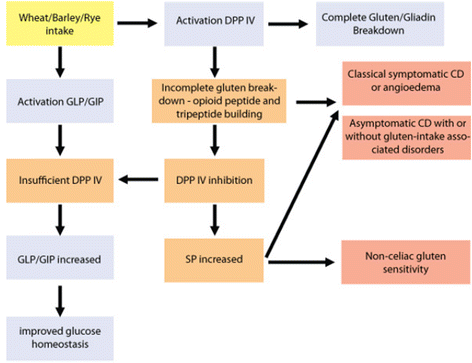The opioid effects of gluten exorphins: asymptomatic celiac disease
- PMID: 26825414
- PMCID: PMC5025969
- DOI: 10.1186/s41043-015-0032-y
The opioid effects of gluten exorphins: asymptomatic celiac disease
Abstract
Gluten-containing cereals are a main food staple present in the daily human diet, including wheat, barley, and rye. Gluten intake is associated with the development of celiac disease (CD) and related disorders such as diabetes mellitus type I, depression, and schizophrenia. However, until now, there is no consent about the possible deleterious effects of gluten intake because of often failing symptoms even in persons with proven CD. Asymptomatic CD (ACD) is present in the majority of affected patients and is characterized by the absence of classical gluten-intolerance signs, such as diarrhea, bloating, and abdominal pain. Nevertheless, these individuals very often develop diseases that can be related with gluten intake. Gluten can be degraded into several morphine-like substances, named gluten exorphins. These compounds have proven opioid effects and could mask the deleterious effects of gluten protein on gastrointestinal lining and function. Here we describe a putative mechanism, explaining how gluten could "mask" its own toxicity by exorphins that are produced through gluten protein digestion.
Figures

Similar articles
-
Properties of Gluten Intolerance: Gluten Structure, Evolution, Pathogenicity and Detoxification Capabilities.Nutrients. 2016 Oct 18;8(10):644. doi: 10.3390/nu8100644. Nutrients. 2016. PMID: 27763541 Free PMC article. Review.
-
Gluten Exorphins Promote Cell Proliferation through the Activation of Mitogenic and Pro-Survival Pathways.Int J Mol Sci. 2023 Feb 15;24(4):3912. doi: 10.3390/ijms24043912. Int J Mol Sci. 2023. PMID: 36835317 Free PMC article.
-
Selected Probiotic Lactobacilli Have the Capacity To Hydrolyze Gluten Peptides during Simulated Gastrointestinal Digestion.Appl Environ Microbiol. 2017 Jun 30;83(14):e00376-17. doi: 10.1128/AEM.00376-17. Print 2017 Jul 15. Appl Environ Microbiol. 2017. PMID: 28500039 Free PMC article.
-
ACG clinical guidelines: diagnosis and management of celiac disease.Am J Gastroenterol. 2013 May;108(5):656-76; quiz 677. doi: 10.1038/ajg.2013.79. Epub 2013 Apr 23. Am J Gastroenterol. 2013. PMID: 23609613 Free PMC article.
-
[A review of diseases related to the intake of gluten].Nutr Hosp. 2015 Jun 1;31(6):2359-71. doi: 10.3305/nh.2015.31.6.8984. Nutr Hosp. 2015. PMID: 26040340 Review. Spanish.
Cited by
-
Role of gastrointestinal health in managing children with autism spectrum disorder.World J Clin Pediatr. 2023 Sep 9;12(4):171-196. doi: 10.5409/wjcp.v12.i4.171. eCollection 2023 Sep 9. World J Clin Pediatr. 2023. PMID: 37753490 Free PMC article. Review.
-
A New Proposal for the Pathogenic Mechanism of Non-Coeliac/Non-Allergic Gluten/Wheat Sensitivity: Piecing Together the Puzzle of Recent Scientific Evidence.Nutrients. 2017 Nov 2;9(11):1203. doi: 10.3390/nu9111203. Nutrients. 2017. PMID: 29099090 Free PMC article. Review.
-
Leaky gut biomarkers in casein- and gluten-rich diet fed rat model of autism.Transl Neurosci. 2021 Dec 31;12(1):601-610. doi: 10.1515/tnsci-2020-0207. eCollection 2021 Jan 1. Transl Neurosci. 2021. PMID: 35070443 Free PMC article.
-
OWL-NETS: Transforming OWL Representations for Improved Network Inference.Pac Symp Biocomput. 2018;23:133-144. Pac Symp Biocomput. 2018. PMID: 29218876 Free PMC article.
-
Non-celiac gluten sensitivity: All wheat attack is not celiac.World J Gastroenterol. 2017 Oct 28;23(40):7201-7210. doi: 10.3748/wjg.v23.i40.7201. World J Gastroenterol. 2017. PMID: 29142467 Free PMC article. Review.
References
-
- Tatham AS, Shewry PR. Allergens to wheat and related cereals. Clin Exp Allergy. 2008;38(11):1712–26. - PubMed
-
- Strohle A, Wolters M, Hahn A. Celiac disease--the chameleon among the food intolerances. Med Monatsschr Pharm. 2013;36(10):369–80. - PubMed
-
- Bybrant MC, Ortqvist E, Lantz S, Grahnquist L. High prevalence of celiac disease in Swedish children and adolescents with type 1 diabetes and the relation to the Swedish epidemic of celiac disease: a cohort study. Scand J Gastroenterol. 2014;49(1):52–8. doi: 10.3109/00365521.2013.846403. - DOI - PubMed
Publication types
MeSH terms
Substances
LinkOut - more resources
Full Text Sources
Other Literature Sources
Medical

